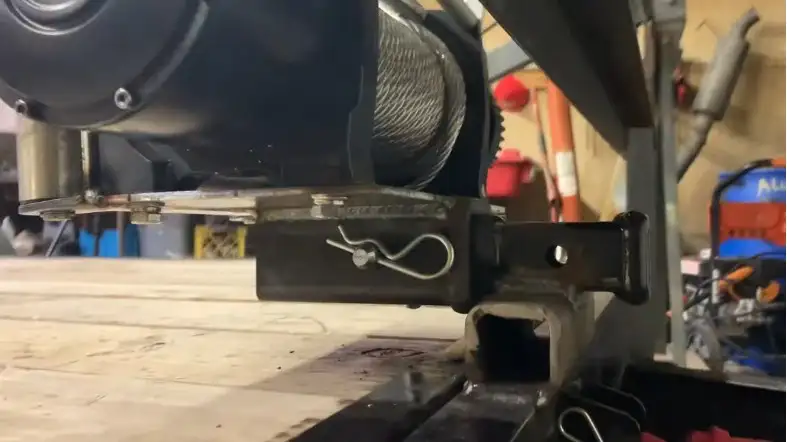We understand the importance of properly mounting a winch to a trailer. From boat owners to off-road adventurers, we’ll teach you how to secure your winch like a pro.
Our comprehensive guide will walk you through the process step-by-step.
With our expert advice and attention to detail, you’ll learn how to mount a winch to a trailer like a pro, ensuring maximum safety, functionality, and convenience.
How To Mount A Winch To A Trailer?
Mounting a winch to a trailer involves several key steps. First, assess your trailer’s specifications and winch requirements. Next, choose the right winch based on load capacity and durability.
Evaluate the mounting location, considering strength and accessibility. Install a winch stand or mounting plate for stability.
Then, mount the winch securely using provided hardware. Wire the winch properly, ant test its functionality and learn safety protocols.
8 Steps to Mount a Winch To a Trailer
Step 1: Assess Your Trailer and Winch Requirements
Before installing a winch on your trailer, it’s essential to assess your trailer’s weight capacity and the intended use of the winch.
Consider the type of load you plan to haul and the winch’s line pull capacity, power source, and mounting location.
Step 2: Selecting the Right Winch for Your Trailer
Selecting a winch is crucial. Look at its load capacity. This is how much weight it can pull. Also, consider its line speed. This is how fast it pulls the load. It’s important to have a winch that can last long, so think about its durability.
Some winches are electric, others are hydraulic. Your needs will determine the best one. You should also look at the winch’s features, such as its control options, weather resistance, and additional safety mechanisms.
Step 3: Evaluating the Mounting Location
Now, you need to decide where to mount your winch. This is important for safety and efficiency. Examine your trailer’s front structure.
Make sure it can withstand the force from the winch. Find a sturdy spot to attach the winch. This could be the trailer’s frame or a point made for winch mounting.
The spot should be easy to reach and work on. It should also be free from anything that could get in the way.
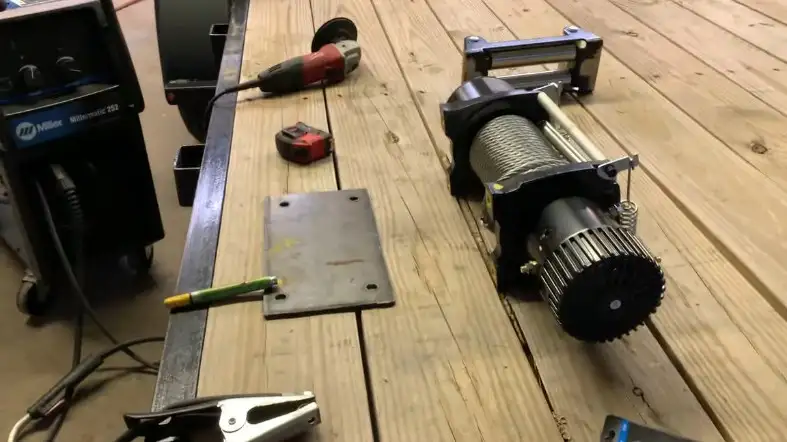
Step 4: Gather Necessary Tools And Equipment
- Wrench set
- Socket set
- Drill
- 1/2″ drill bit
- Tape measure
- Level
- Pencil or marker
- Ratchet straps (optional)
Step 5: Installing the Winch Stand or Mounting Plate
To provide a stable platform for your winch, you may need to install a winch stand or mounting plate. These components distribute the weight properly, reducing stress on the trailer and improving overall safety. Follow bellow instructions carefully to securely attach the winch stand or mounting plate to the trailer frame.
- Drill mounting holes– Use a drill to drill mounting holes in the trailer frame. The holes should be large enough to accommodate the mounting hardware that came with your winch stand or mounting plate.
- Attach the winch stand or mounting plate– Secure the winch stand or mounting plate to the trailer frame using the mounting hardware. Make sure that the stand or mounting plate is level and that the bolts are tight.
- Test the winch stand or mounting plate– Once the winch stand or mounting plate is attached, test it to make sure it is secure. You can do this by pulling on the winch cable with a force of at least 500 pounds.
Ensure proper alignment and reinforcement for a reliable installation. Also consider following:
- Use a level to make sure the winch stand or mounting plate is level.
- Use washers to distribute the load evenly.
- Tighten the bolts until they are snug, but do not overtighten them.
- Test the winch stand or mounting plate to make sure it is secure.
Step 6: Mounting the Winch
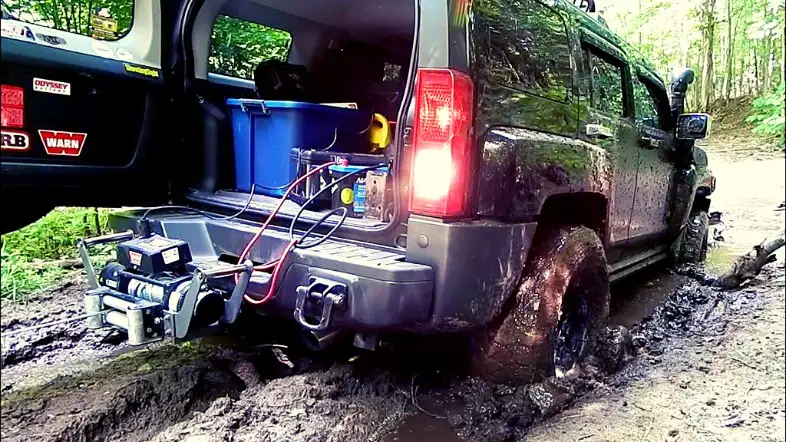
With the winch stand or mounting plate in place, it’s time to mount the winch itself. Position the winch on the stand or plate, aligning the mounting holes on both components.
Use the provided hardware, usually bolts or screws, to tightly secure the winch to the stand or plate.
Tighten all fasteners according to the following recommended torque specifications, ensuring a secure and reliable attachment.
- Clean the fasteners– Before you tighten the fasteners, clean them with a wire brush to remove any dirt or debris. This will help to ensure that the fasteners tighten properly.
- Tighten the fasteners- Start by tightening the fasteners by hand. Once they are snug, use a wrench or socket wrench to tighten them to the specified torque. The torque specification for the fasteners will be listed in the winch’s owner’s manual.
- Recheck the torque– Once you have tightened the fasteners, recheck the torque to make sure that they are tight. You can use a torque wrench to do this.
Here are some additional tips for tightening all fasteners to mount a winch to a trailer:
- Use a torque wrench to ensure that the fasteners are tightened to the correct torque.
- Do not overtighten the fasteners. Overtightening can damage the fasteners or the trailer frame.
- Recheck the torque after a few weeks to make sure that the fasteners have not loosened.
Step 7: Wiring the Winch
For electric winches, proper wiring is essential to ensure efficient power supply and operation. Follow the bellow instructions meticulously to wire the winch to a suitable power source on your trailer, typically the battery. There are two main ways to wire a winch to a trailer:
Directly to the battery
This is the most common way to wire a winch. You will need to run a power cable from the winch to the battery. The power cable should be a heavy-duty cable that is rated for the amperage draw of the winch.
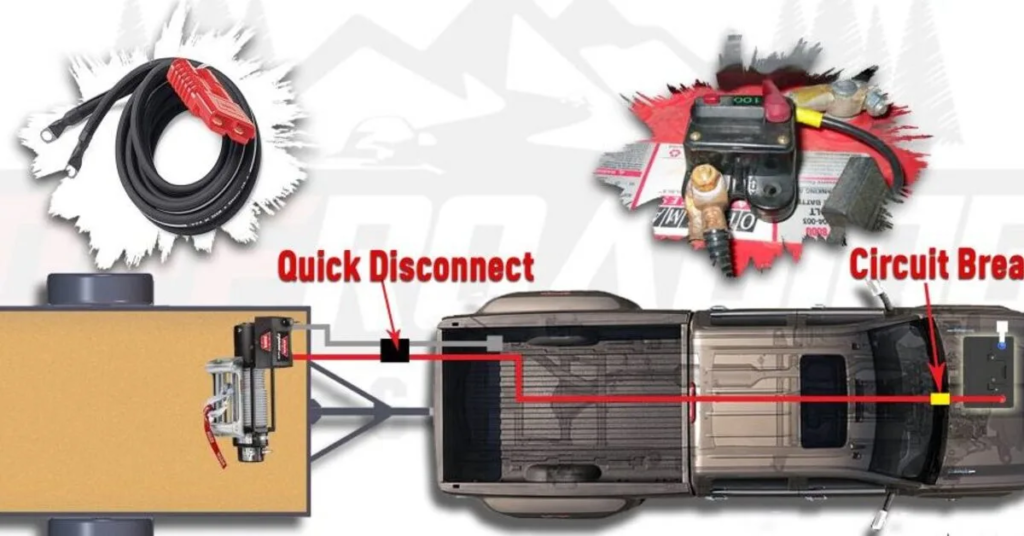
Steps to wire a winch directly to the battery:
- Locate the battery. The battery is usually located under the hood of the vehicle that is towing the trailer.
- Disconnect the negative battery cable. This will prevent the battery from accidentally discharging while you are wiring the winch.
- Run the power cable from the winch to the battery. The power cable should be routed in a way that it will not be damaged.
- Connect the power cable to the battery. Make sure that the positive and negative terminals are connected correctly.
- Reconnect the negative battery cable.
Through the trailer’s 7-way connector
This is a less common way to wire a winch, but it is an option if your trailer has a 7-way connector. You will need to purchase a winch wiring kit that is specifically designed for 7-way connectors.
Steps to wire a winch through the trailer’s 7-way connector:
- Locate the 7-way connector. The 7-way connector is usually located on the back of the trailer.
- Purchase a winch wiring kit that is specifically designed for 7-way connectors. The kit will include a power cable, a fuse, and a mounting bracket.
- Install the mounting bracket on the trailer. The mounting bracket should be installed in a location that is accessible, but out of the way.
- Run the power cable from the winch to the mounting bracket. The power cable should be routed in a way that it will not be damaged.
- Connect the power cable to the 7-way connector. Make sure that the positive and negative terminals are connected correctly.
- Install the fuse. The fuse should be installed in the fuse holder that is included in the winch wiring kit.
Use appropriate wire gauge and connectors for secure and weather-resistant connections. Consider using fuses or circuit breakers for additional protection.
Step 8: Testing and Safety Considerations
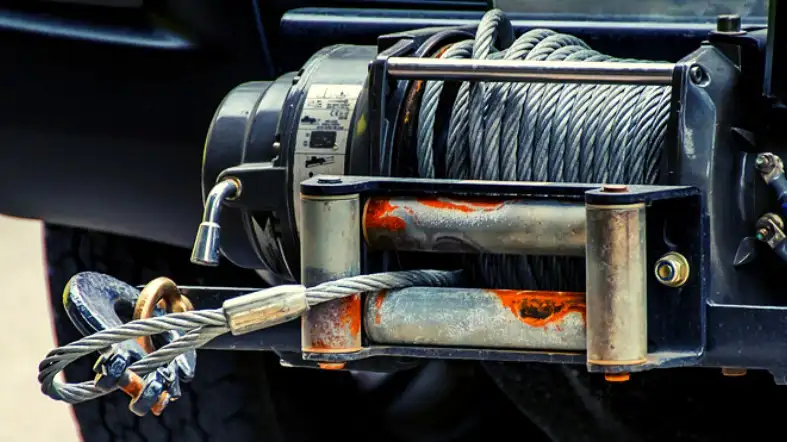
Once the winch is securely mounted and properly wired, it’s crucial to conduct thorough testing to ensure its functionality and safety.
Test the winch under load conditions, ensuring it operates smoothly and pulls with the expected power. Verify that the winch’s controls are responsive and that the load is released properly.
Additionally, familiarize yourself with winch safety protocols, including proper handling, maintenance, and precautions to prevent accidents or damage.
What To Keep In Mind When Using A Winch On Your Trailer?
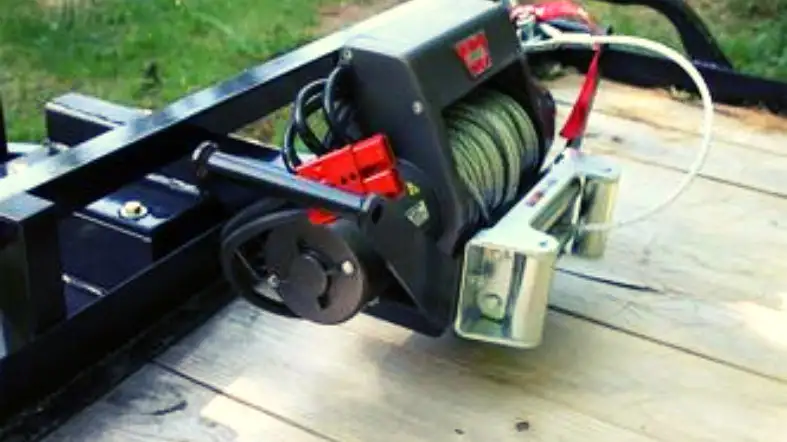
There are a few things you need to keep in mind when using a winch on your trailer.
First, always make sure the area around the winch is clear before use.
This will prevent any accidental injuries. Second, always follow the manufacturer’s instructions for safe operation.
This includes proper usage of the winch and its parts. Third, be aware of your surroundings and what you’re pulling with the winch.
Make sure there’s nothing in the way that could get caught or damaged during use.
And fourth, always inspect the winch and its parts before each use. This will ensure that everything is in good working condition.
If you keep these things in mind, you’ll be able to use your winch safely and effectively.
What Are The Different Winch Mounting Methods On The Trailer?
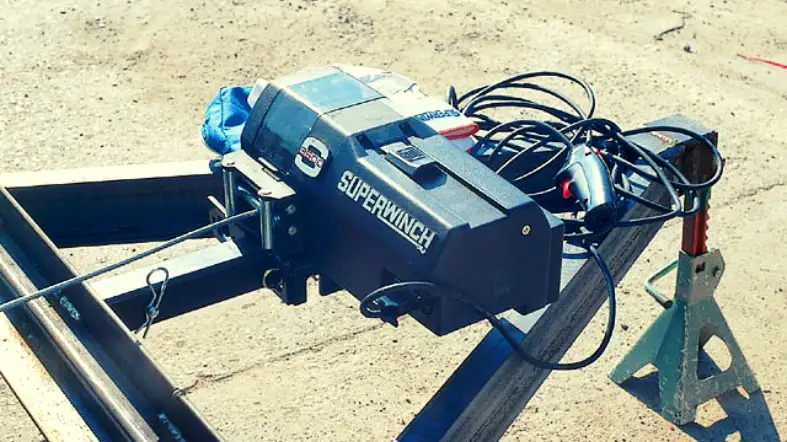
- On Car, Utility, Snowmobile & Flatbed Trailer
- On Enclosed Trailer
- On Tilt Deck Trailer
- On Gooseneck Trailer
- On Fifth Wheel Trailer
- On Large Boat Trailers
1. On Car, Utility, Snowmobile & Flatbed Trailers
One of the most popular methods for mounting a winch on a trailer is using brackets that bolt to the frame.
This method is strong and secure, making it ideal for trailers that carry heavy loads or go off-road frequently.
2. On Enclosed Trailers
Another popular method for mounting a winch on an enclosed trailer is using a plate that bolts to the floor.
This provides a solid foundation for the winch and prevents it from bouncing around while in use.
3. On Tilt Deck Trailers
If you have a tilt deck trailer, you can mount the winch directly to the deck.
This gives you easy access to the winch and keeps it out of the way when the deck is tilted.
4. On Gooseneck Trailers
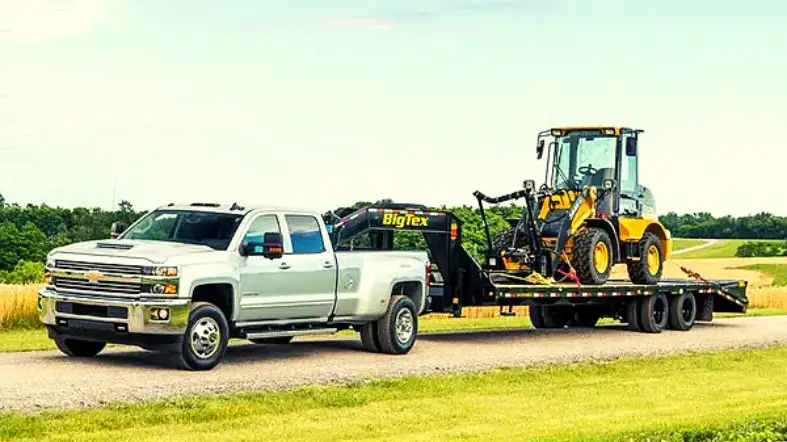
Gooseneck trailers have a special hitch that allows them to be attached to a truck’s bed.
This makes them ideal for carrying heavy loads.
You can mount the winch directly to the gooseneck hitch, which provides a strong and secure foundation.
5. On Fifth Wheel Trailers
Fifth-wheel trailers are large trailers that are designed to be towed by trucks with a special hitch in the bed.
You can mount the winch directly to the fifth wheel hitch, which provides a strong and secure foundation.
6. On Large Boat Trailers
If you have a large boat trailer, you can mount the winch to the tongue.
This provides a strong and secure foundation for the winch and keeps it out of the way when loading and unloading your boat.
No matter what type of trailer you have, there’s a method for mounting a winch that will work for you.
Be sure to consider your needs carefully before choosing a method so you can be sure it will work well for you.
How To Wire A Winch On The Trailer?
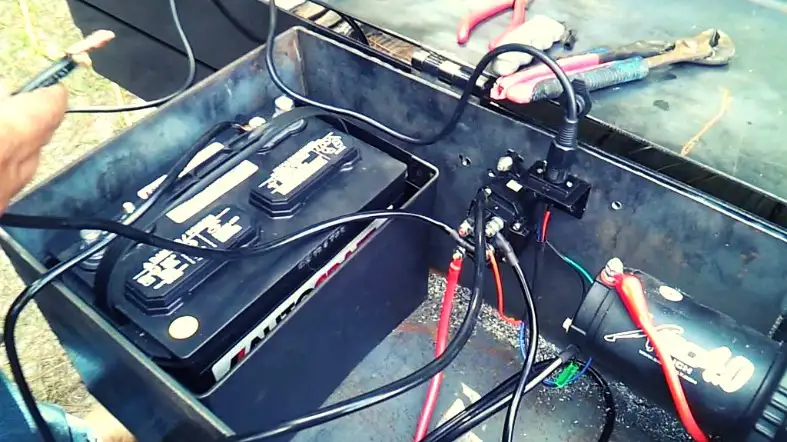
If you’re mounting a winch on your trailer, you’ll need to wire it properly to ensure it works correctly.
Wiring a winch is relatively simple, but it’s important to do it correctly to avoid damage to your electrical system.
To wire a winch, you’ll need:
- A battery charger
- An electrical circuit tester
- Wiring kit for your winch
- Wire cutters/strippers
1. First, charge the battery for your winch. This will ensure that it has enough power to operate correctly.
2. Next, use an electrical circuit tester to test the wiring on your trailer.
You’ll need to know which wires are positive and negative so you can wire the winch correctly.
3. Once you know which wires are which, use a wiring kit to connect the winch to your trailer’s electrical system.
Be sure to follow the instructions that come with the kit so you wire it correctly.
4. Finally, use wire cutters or strippers to strip the insulation off the end of the wires.
This will allow you to connect the winch to your trailer’s electrical system.
5. After you’ve wired the winch, be sure to test it before using it.
This will ensure that it’s working properly and avoid any damage to your electrical system.
Tips for using a winch on your trailer:
1. Be sure to read the instructions that come with your winch before using it.
This will ensure that you use it correctly and avoid any damage to your trailer or its contents.
2. Inspect your winch before each use. This will ensure that it’s in good condition and ready to use.
3. Don’t overload your winch. Be sure to check the weight capacity of your winch before using it so you don’t damage it.
4. Use a winch cover when not in use. This will protect your winch from the elements and keep it in good condition.
5. Store your winch in a dry, safe place when not in use. This will prevent damage and keep it ready for your next trip.
Following these tips will help you get the most out of your winch and avoid any damage to your trailer or its contents.
Winching Techniques
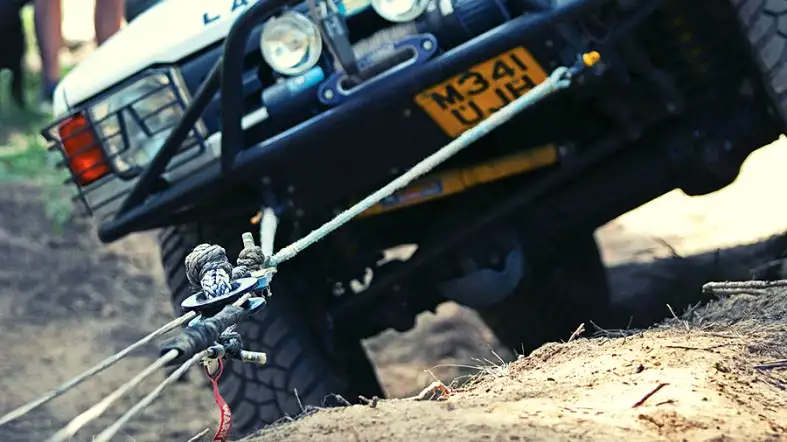
There are a few different techniques you can use when winching your trailer.
The technique you use will depend on the type of trailer you have and the conditions you’re winching in.
1. The double-line pull is the most common winching technique. It’s used for trailers that have a coupler or hitch at the front.
To do a double-line pull, attach one line from the winch to the front of the trailer and another line to the rear.
Winch the front of the trailer until it’s tight against the hitch, then winch the rear until it’s tight against the coupler.
This will give you a snug, secure fit.
2. The single-line pull is used for trailers that don’t have a coupler or hitch at the front.
To do a single-line pull, attach one line from the winch to the front of the trailer.
Winch the front of the trailer until it’s tight against the tongue.
3. The snatch block is used for trailers that have a coupler or hitch at the front.
To do a snatch block, attach one line from the winch to the front of the trailer and another line to the rear.
Winch the front of the trailer until it’s tight against the hitch, then winch the rear until it’s tight against the coupler.
4. The bridle is used for trailers that have a coupler or hitch at the front.
To do a bridle, attach one line from the winch to the front of the trailer and another line to the rear.
Winch the front of the trailer until it’s tight against the hitch, then winch the rear until it’s tight against the coupler.
5. The choker is used for trailers that have a coupler or hitch at the front.
To do a choker, attach one line from the winch to the front of the trailer and another line to the rear.
Winch the front of the trailer until it’s tight against the hitch, then winch the rear until it’s tight against the coupler.
FAQs on How To Mount A Winch To A Trailer
What do I need to mount a winch on my trailer?
To mount a winch on your trailer, you’ll need the winch itself, a winch mount, bolts and nuts, electrical wiring, and a winch controller.
Can I install a winch on my trailer myself?
Yes, you can install a winch on your trailer yourself if you have basic mechanical skills and the proper tools.
However, if you are unsure about the process, it’s recommended to seek the assistance of a professional.
What is a winch mount and where do I get one?
A winch mount is a bracket that is attached to the trailer to secure the winch in place.
You can purchase a winch mount at an automotive supply store or online.
How do I control the winch while it’s in use?
A winch controller is used to control the winch while it’s in use.
The controller can be mounted on the winch itself or on the vehicle.
The winch can be operated using a wired remote or a wireless remote control.
Conclusion
Mounting a winch on your trailer can greatly increase its utility and versatility.
It’s important to carefully consider your needs and choose the right winch for your trailer.
The installation process requires basic mechanical skills and the proper tools, and it’s recommended to seek the assistance of a professional if you are unsure.
Once installed, the winch must be regularly maintained to ensure it continues to function properly.
With a properly installed and maintained winch, your trailer will be ready to tackle any heavy load.

